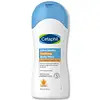What's inside
What's inside
 Key Ingredients
Key Ingredients

No key ingredients
 Benefits
Benefits

 Concerns
Concerns

 Ingredients Side-by-side
Ingredients Side-by-side

Water
Skin ConditioningGlycerin
HumectantSodium Laureth Sulfate
CleansingCocamidopropyl Betaine
CleansingDisodium Laureth Sulfosuccinate
CleansingBetaine
HumectantCalendula Officinalis Flower Extract
MaskingAloe Barbadensis Leaf Juice Powder
Skin ConditioningPanthenol
Skin ConditioningParfum
MaskingGlycol Distearate
EmollientAcrylates/C10-30 Alkyl Acrylate Crosspolymer
Emulsion StabilisingLauryl Lactate
EmollientCitric Acid
BufferingSodium Benzoate
MaskingPhenoxyethanol
PreservativeSodium Citrate
BufferingLaureth-4
EmulsifyingHydrolyzed Wheat Protein
Skin ConditioningHeliotropine
MaskingPolyquaternium-10
Sodium Hydroxide
BufferingWater, Glycerin, Sodium Laureth Sulfate, Cocamidopropyl Betaine, Disodium Laureth Sulfosuccinate, Betaine, Calendula Officinalis Flower Extract, Aloe Barbadensis Leaf Juice Powder, Panthenol, Parfum, Glycol Distearate, Acrylates/C10-30 Alkyl Acrylate Crosspolymer, Lauryl Lactate, Citric Acid, Sodium Benzoate, Phenoxyethanol, Sodium Citrate, Laureth-4, Hydrolyzed Wheat Protein, Heliotropine, Polyquaternium-10, Sodium Hydroxide
Water
Skin ConditioningGlycerin
HumectantMenthol
MaskingCetyl Alcohol
EmollientCetearyl Alcohol
EmollientPalmitic Acid
EmollientPropanediol
SolventCyclopentasiloxane
EmollientStearic Acid
CleansingC12-15 Alkyl Benzoate
AntimicrobialCeramide NP
Skin ConditioningCeramide AP
Skin ConditioningCeramide As
Skin ConditioningCeramide Ns
Skin ConditioningCeramide EOP
Skin ConditioningCholesterol
EmollientPCA
HumectantSaccharide Isomerate
HumectantArginine
MaskingPhytosteryl/Octyldodecyl Lauroyl Glutamate
Skin ConditioningCaprylyl Glycol
EmollientCyclohexasiloxane
EmollientCetearyl Glucoside
EmulsifyingCarbomer
Emulsion Stabilising1,2-Hexanediol
Skin ConditioningDipropylene Glycol
HumectantCitric Acid
BufferingSodium Citrate
BufferingTropolone
Skin ConditioningHydrogenated Lecithin
EmulsifyingGlyceryl Stearate
EmollientWater, Glycerin, Menthol, Cetyl Alcohol, Cetearyl Alcohol, Palmitic Acid, Propanediol, Cyclopentasiloxane, Stearic Acid, C12-15 Alkyl Benzoate, Ceramide NP, Ceramide AP, Ceramide As, Ceramide Ns, Ceramide EOP, Cholesterol, PCA, Saccharide Isomerate, Arginine, Phytosteryl/Octyldodecyl Lauroyl Glutamate, Caprylyl Glycol, Cyclohexasiloxane, Cetearyl Glucoside, Carbomer, 1,2-Hexanediol, Dipropylene Glycol, Citric Acid, Sodium Citrate, Tropolone, Hydrogenated Lecithin, Glyceryl Stearate
 Reviews
Reviews

Ingredients Explained
These ingredients are found in both products.
Ingredients higher up in an ingredient list are typically present in a larger amount.
Citric Acid is an alpha hydroxy acid (AHA) naturally found in citrus fruits like oranges, lemons, and limes.
Like other AHAs, citric acid can exfoliate skin by breaking down the bonds that hold dead skin cells together. This helps reveal smoother and brighter skin underneath.
However, this exfoliating effect only happens at high concentrations (20%) which can be hard to find in cosmetic products.
Due to this, citric acid is usually included in small amounts as a pH adjuster. This helps keep products slightly more acidic and compatible with skin's natural pH.
In skincare formulas, citric acid can:
While it can provide some skin benefits, research shows lactic acid and glycolic acid are generally more effective and less irritating exfoliants.
Most citric acid used in skincare today is made by fermenting sugars (usually from molasses). This synthetic version is identical to the natural citrus form but easier to stabilize and use in formulations.
Read more about some other popular AHA's here:
Learn more about Citric AcidGlycerin is already naturally found in your skin. It helps moisturize and protect your skin.
A study from 2016 found glycerin to be more effective as a humectant than AHAs and hyaluronic acid.
As a humectant, it helps the skin stay hydrated by pulling moisture to your skin. The low molecular weight of glycerin allows it to pull moisture into the deeper layers of your skin.
Hydrated skin improves your skin barrier; Your skin barrier helps protect against irritants and bacteria.
Glycerin has also been found to have antimicrobial and antiviral properties. Due to these properties, glycerin is often used in wound and burn treatments.
In cosmetics, glycerin is usually derived from plants such as soybean or palm. However, it can also be sourced from animals, such as tallow or animal fat.
This ingredient is organic, colorless, odorless, and non-toxic.
Glycerin is the name for this ingredient in American English. British English uses Glycerol/Glycerine.
Learn more about GlycerinSodium Citrate is the sodium salts of citric acid. In skincare, it is used to alter pH levels and acts as a preservative.
Its main functions are to maintain the pH of a product and neutralize metal ions.
The acidity of our skin is maintained by our glands and skin biome; normal pH level of skin is slightly acidic (~4.75-5.5).
Being slightly acidic allows our skin to create an "acid mantle". This acid mantle is a thin barrier that protects our skin from bacteria and contaminants.
Learn more about Sodium CitrateWater. It's the most common cosmetic ingredient of all. You'll usually see it at the top of ingredient lists, meaning that it makes up the largest part of the product.
So why is it so popular? Water most often acts as a solvent - this means that it helps dissolve other ingredients into the formulation.
You'll also recognize water as that liquid we all need to stay alive. If you see this, drink a glass of water. Stay hydrated!
Learn more about Water